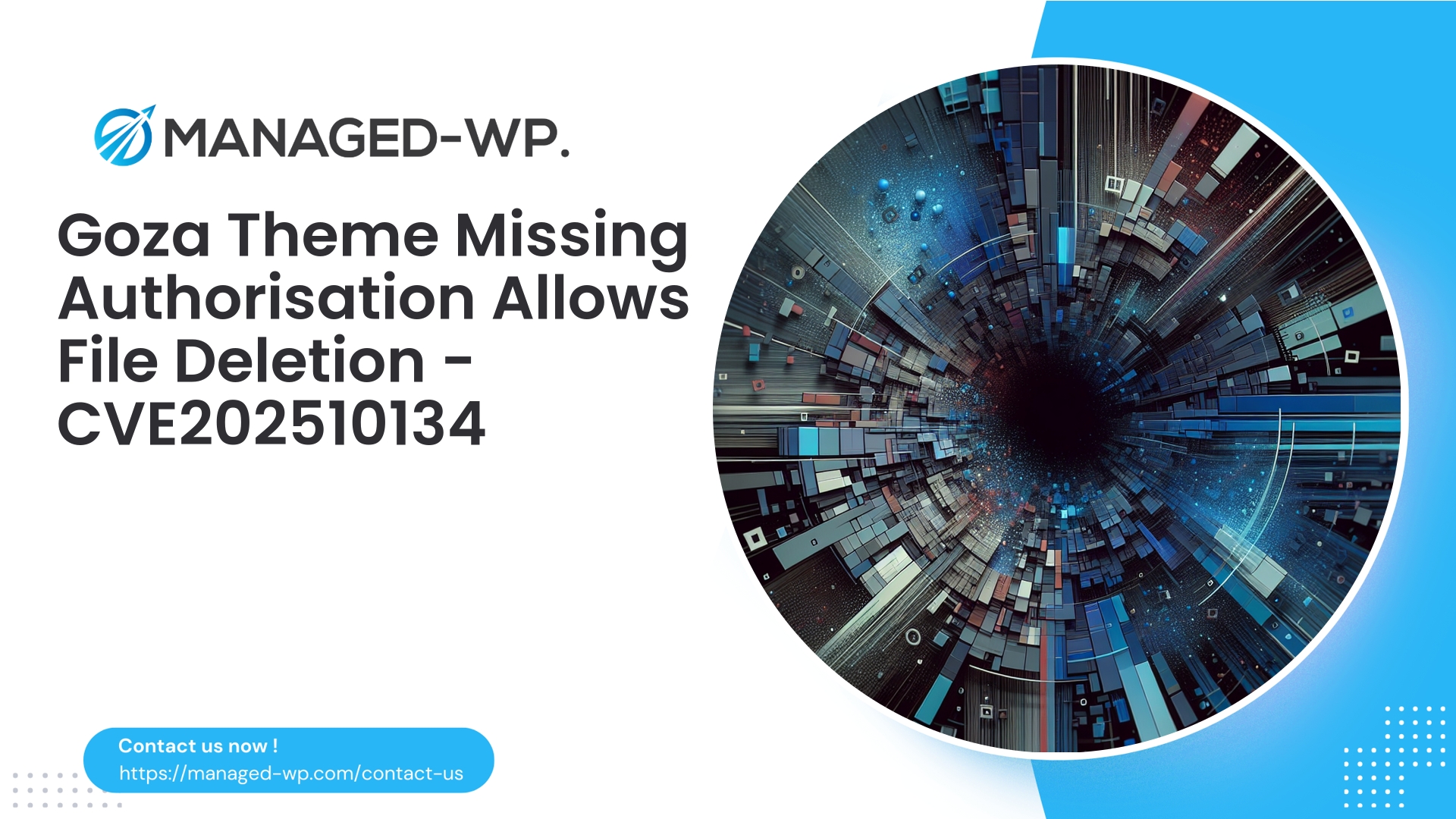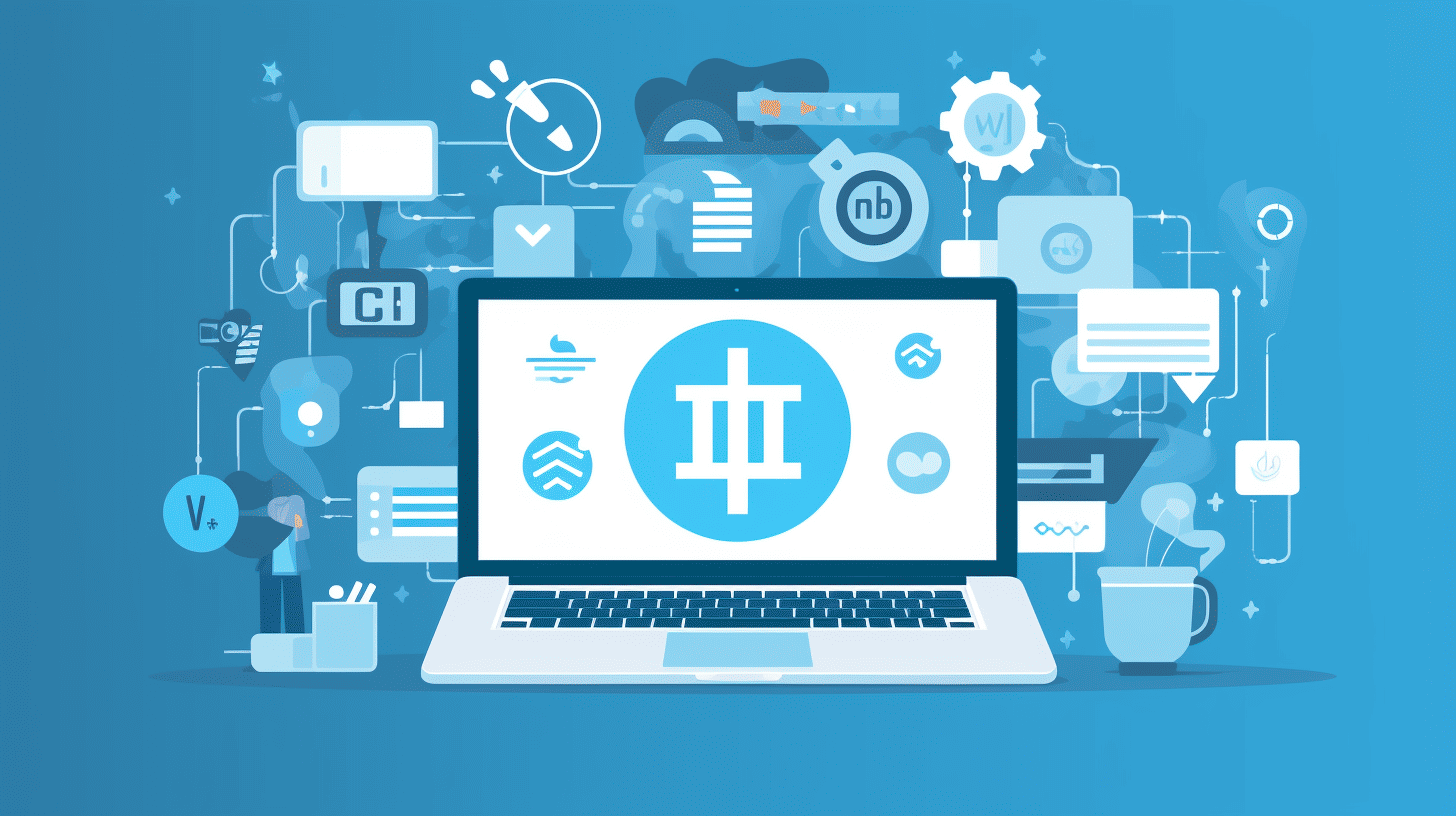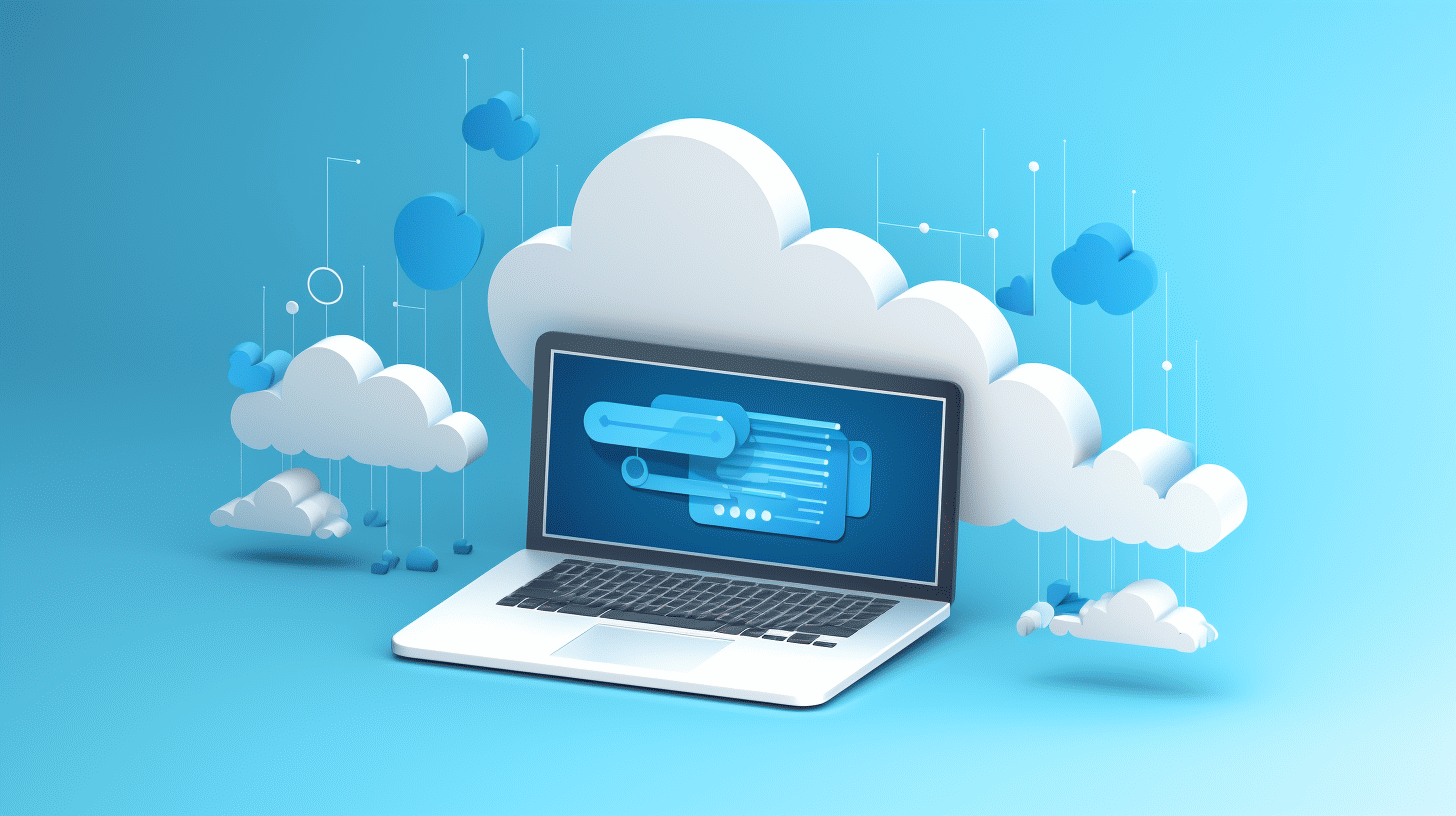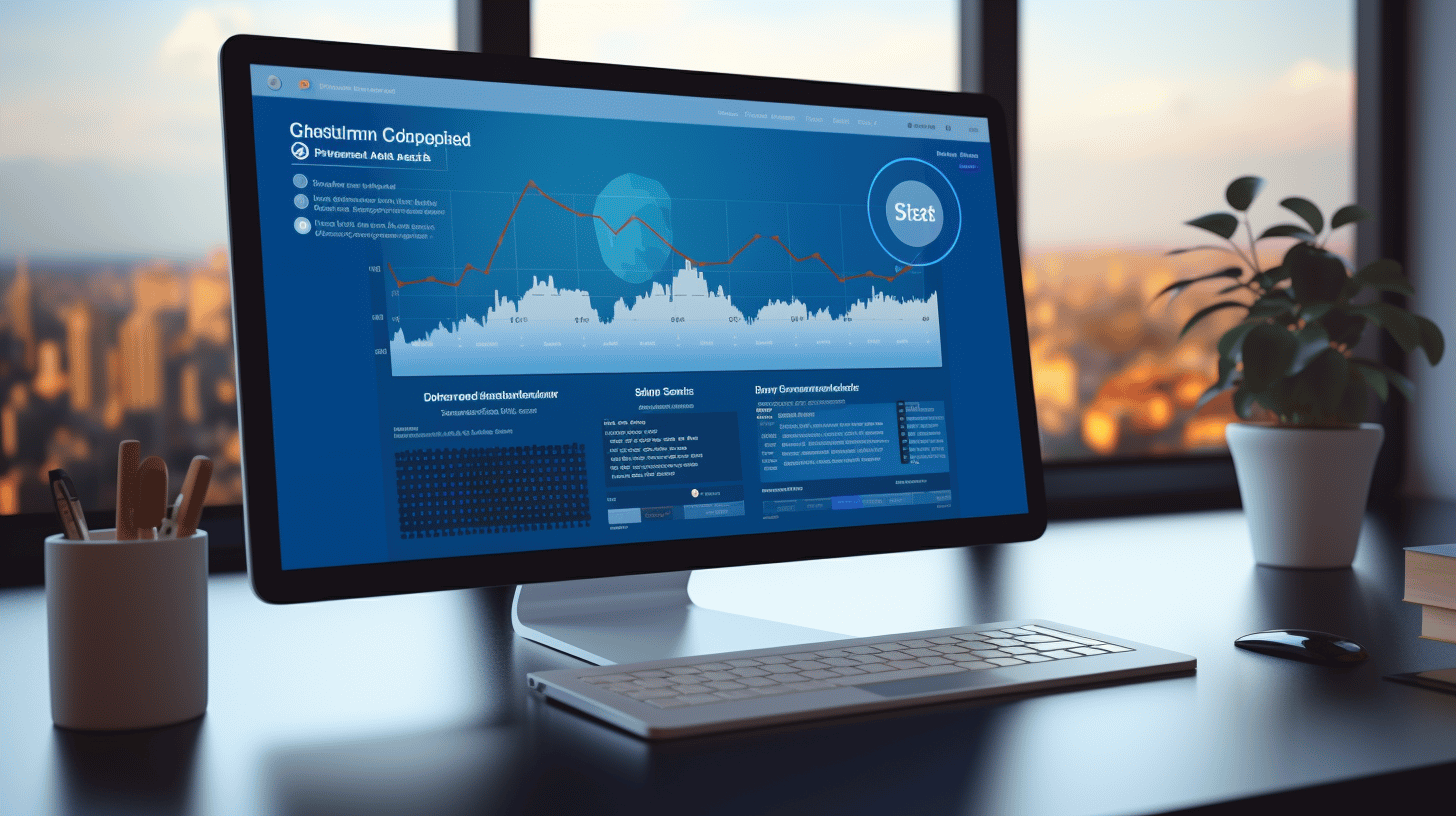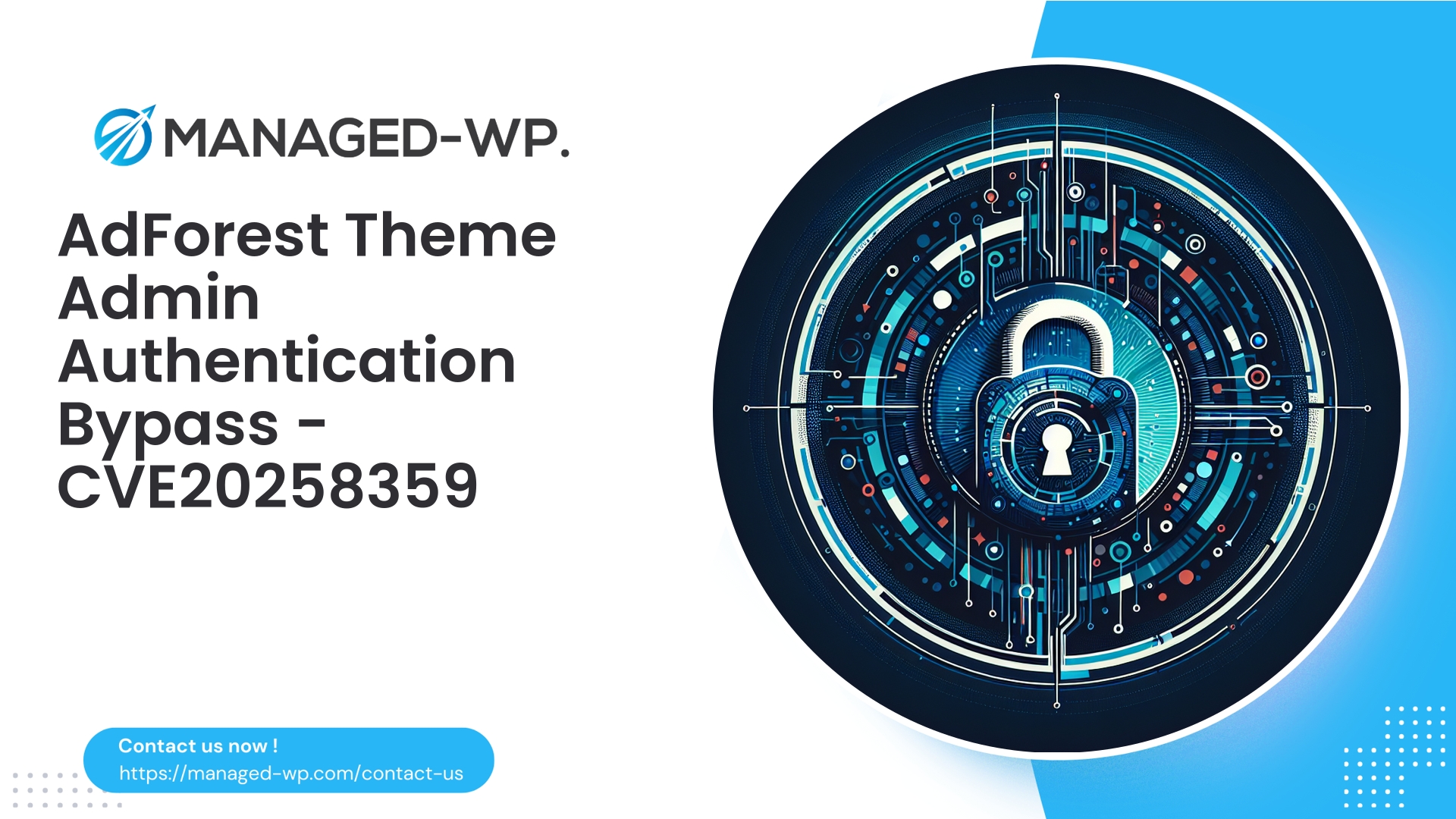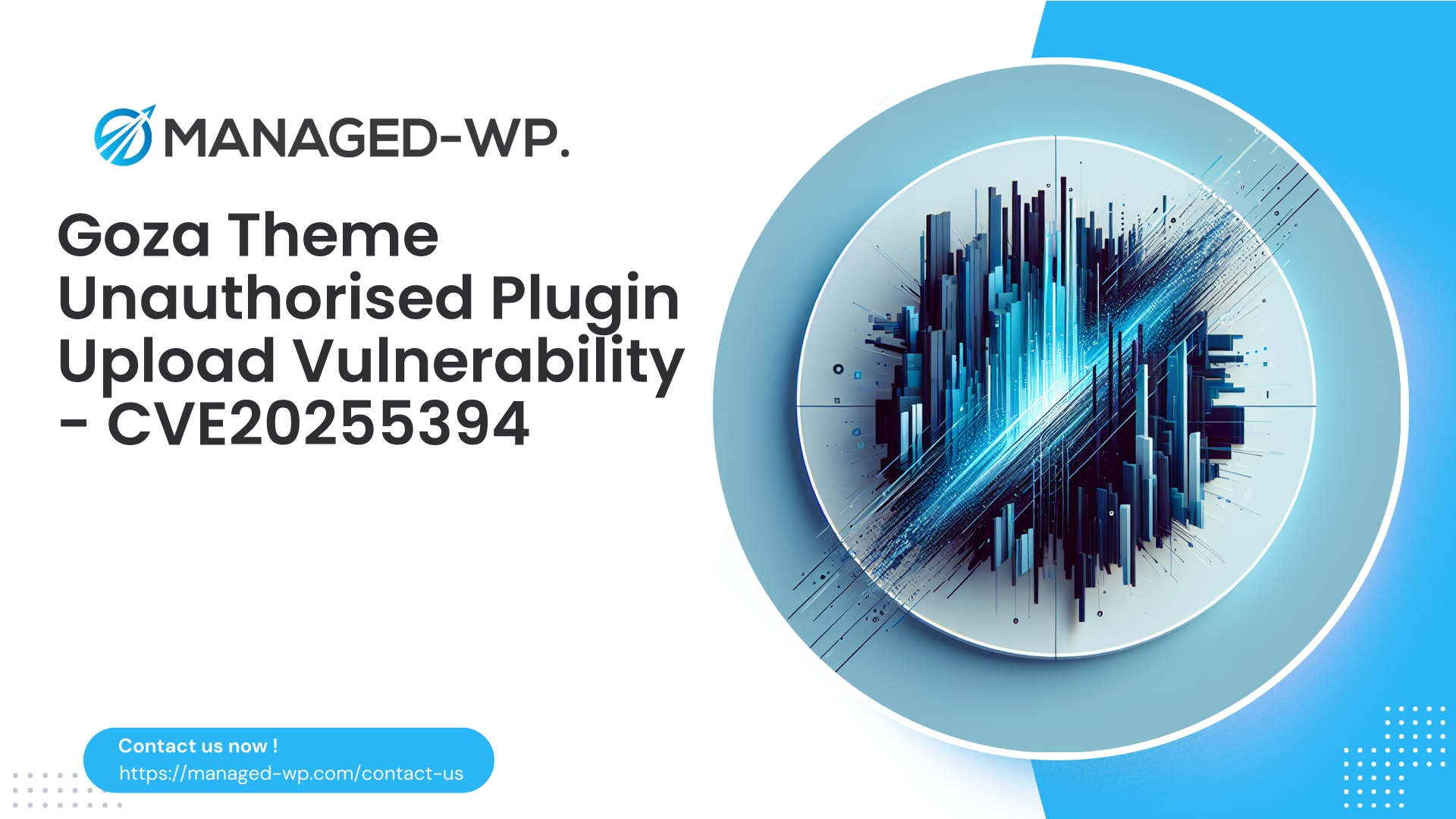| 插件名稱 | 戈札 |
|---|---|
| 漏洞類型 | 任意檔案刪除 |
| CVE編號 | CVE-2025-10134 |
| 緊急 | 高的 |
| CVE 發布日期 | 2025-09-08 |
| 來源網址 | CVE-2025-10134 |
緊急安全警報:Goza 主題(≤ 3.2.2)— 嚴重未經身份驗證的任意文件刪除漏洞 (CVE-2025-10134) — 來自 Managed-WP 的專家分析和緩解措施
執行摘要
Goza WordPress 主題中發現了一個嚴重漏洞,影響所有 3.2.2 及更早版本。該漏洞允許未經身份驗證的攻擊者刪除受感染網站上的任意檔案。此漏洞編號為 CVE-2025-10134,CVSS 評分為 8.6,屬於高風險漏洞。我們強烈建議所有使用 Goza 主題的網站管理員和開發人員立即更新至 3.2.3 或更高版本。如果無法立即進行補丁更新,請實施以下建議和虛擬補丁策略以降低風險。
本報告由 Managed-WP 的安全專家提供權威觀點,旨在為 WordPress 網站所有者、開發人員和事件回應人員提供清晰的見解、檢測技術和可操作的防禦措施。
為什麼這種漏洞需要立即關注
- 允許未經身份驗證的攻擊者在無需登入憑證的情況下刪除文件,由於自動化利用的便利性,大大增加了風險。
- 隨意刪除文件會立即破壞網站功能,因為它會刪除關鍵的主題、外掛程式或 WordPress 核心文件,從而導致停機和資料遺失。
- 攻擊者可能會利用檔案刪除作為更廣泛的攻擊鏈的第一步,這些攻擊鏈可能涉及檔案篡改、持久後門或網站破壞。
- 根本原因在於授權檢查有缺陷以及檔案路徑驗證不足,因此將其歸類為注入/授權漏洞。
鑑於問題的嚴重性和潛在的攻擊風險,必須將修補程式部署作為當務之急的安全措施。
揭露的技術摘要
- 受影響的軟體: Goza WordPress主題
- 易受攻擊的版本: 3.2.2 及更早版本
- 已修復版本: 3.2.3
- 漏洞: 缺少允許任意刪除檔案的授權
- CVE標識符: CVE-2025-10134
- 所需權限等級: 無(未經認證)
- 嚴重程度: 高(CVSS 8.6)
- 公開揭露日期: 2025年9月8日
注意:為確保安全操作,本安全公告不包含漏洞程式碼。重點在於風險認知和緩解。
攻擊向量概述:威脅行為者如何利用此漏洞
- 偵察: 攻擊者使用常見的指紋辨識工具來識別執行 Goza 主題的目標網站。
- 相互作用: 攻擊者使用自動化腳本探測主題中的易受攻擊端點。
- 執行: 發送旨在利用檔案刪除處理程序的惡意請求,繞過授權。
- 影響: 任意檔案(包括關鍵主題範本或設定檔)被刪除,可能會擾亂網站運作。
- 後剝削時代: 隨後可能會出現進一步的惡意活動,例如透過後門進行持久化攻擊或拒絕服務攻擊。
缺乏身份驗證機制使得攻擊者能夠利用這一漏洞,這凸顯了該威脅的嚴重性和可擴展性。
網站管理員應立即採取的補救措施
- 立即套用官方主題更新:
- 請立即將 Goza 主題升級至 3.2.3 或更高版本,以徹底解決此漏洞。
- 對於進行了自訂的網站,應盡可能在測試環境中測試更新,但請務必將安全性放在首位。
- 如果無法立即更新,可採取以下臨時解決方法:
- 暫時停用 Goza 主題或切換到預設主題或安全的替代主題。
- 如果切換不切實際,則實施進一步的緩解措施,例如虛擬修補和檔案權限限制(詳見下文)。
- 透過防火牆或Web應用防火牆(WAF)實施虛擬修補程式:
- 封鎖所有未經身份驗證的、指向帶有檔案刪除指示符的主題端點的請求。
- 啟用 Managed-WP 防火牆規則集,該規則集旨在保護網站免受此類未經身份驗證的破壞性活動的影響。
- 加強檔案系統權限:
- 限制寫入/刪除權限,防止 Web 伺服器使用者隨意刪除關鍵檔案。
- 將可寫入範圍限制在必要的目錄,例如上傳目錄。
- 確保全面備份:
- 在進行變更或採取緩解措施之前,請建立完整的檔案系統和資料庫備份。
- 備份有助於在資料外洩時進行復原和取證調查。
- 持續日誌監控和事件偵測:
- 檢查伺服器和應用程式日誌,尋找可疑的未經授權的檔案刪除嘗試。
- 保留日誌以供調查和取證之用。
- 掃描是否有洩漏跡象:
- 尋找缺少或修改的主題檔案、意外的 PHP 檔案或未經授權的管理員使用者。
- 如果偵測到入侵,則啟動事件回應程式。
虛擬修補和WAF緩解建議
在官方補丁發布之前,虛擬補丁可以提供關鍵的臨時防禦措施。推薦做法包括:
- 阻止包含可疑參數的未經身份驗證的請求:
- 攔截包含「刪除」、「移除」、「取消連結」等關鍵字或針對主題區域的可疑「檔案」和「路徑」參數的請求。
- 保護主題內部文件:
- 拒絕直接透過 HTTP 存取(403 禁止存取)主題子目錄中的非公開 PHP 包含檔案。
- 限制HTTP方法:
- 封鎖或要求對可能執行檔案刪除操作的 DELETE 或 POST 要求進行驗證。
- 偵測並阻止參數中的路徑遍歷:
- 過濾查詢或 POST 參數中包含「../」或絕對檔案系統路徑的請求。
- 強制執行 WordPress nonce 和會話驗證:
- 涉及檔案系統修改的請求需要有效的 nonce 令牌和登入會話。
規則制定注意事項: 為盡量減少誤報,應採取保守策略。將虛擬修補程式與其他控制措施(例如檔案權限強化和備份)結合,以獲得最佳效果。
需要監測的入侵指標 (IoC)。
- 與已知良好版本相比,發現 Goza 主題文件意外缺失或已修改。
- 突然出現 404 錯誤或網站功能中斷,且與可疑請求相關。
- Web 伺服器日誌顯示對主題相關端點的未經驗證的存取嘗試。
- 來自相同 IP 位址的重複掃描活動,目標是主題檔案。
- 上傳檔案或主題目錄中出現新的或意料以外的 PHP 腳本。
- WordPress資料庫選項發生意外變更或新增管理員使用者。
保留詳細日誌,如果確認入侵發生,立即啟動事件回應協定。
分步式事件回應指南
- 證據保存: 妥善保存所有相關日誌和資料快照,不得進行任何竄改。
- 位點隔離: 考慮在評估期間將受影響的網站離線或限制存取。
- 損失核實: 識別已更改或已刪除的文件;檢查後門和未經授權的帳戶。
- 恢復: 首先在測試環境中使用乾淨的備份和主題包來還原網站。
- 補丁部署和加固: 更新主題、強化密碼、啟用雙重認證、限制權限。
- 恢復後監測: 查看日誌,留意重複的攻擊嘗試和可疑活動。
- 根本原因分析: 分析攻擊手段並相應加強防禦。
如果內部應對能力有限,則應尋求專業緊急應變機構的協助。迅速反應可以減少損失和恢復成本。
防止授權繞過漏洞的開發者最佳實踐
- 嚴格的授權檢查: 始終驗證使用者權限
當前使用者可以()在進行狀態改變操作之前。 - Nonce 驗證: 在所有檔案操作請求(包括 REST 和 AJAX 呼叫)中使用並驗證 WordPress nonce。
- 穩健的路徑清理: 永遠不要信任使用者直接輸入的檔案路徑;將刪除操作限制在白名單目錄內,並使用驗證方法進行驗證。
真實路徑(). - 限制公共端點: 僅在經過驗證的管理員上下文中,使用 WordPress API 實作文件管理。
- 全面日誌記錄: 記錄刪除嘗試,包括使用者身分和上下文,並在出現異常時發出警報。
- 自動化測試: 在持續整合流程中加入授權繞過測試和模糊測試。
- 同儕程式碼審查: 加強程式碼審查,專注於文件操作,以發現安全漏洞。
這些措施可以大幅降低未經授權的文件管理風險。
用於威脅狩獵的搜尋查詢
- 掃描 Web 伺服器日誌,尋找包含可疑參數(例如「../」、「.php」或絕對系統路徑)的主題端點請求。
- 偵測帶有刪除類別參數的未經身份驗證的 AJAX 呼叫。
- 識別事件發生時間線前後 4xx 或 5xx 錯誤數量的激增情況。
- 分析來自相同 IP 位址的先失敗後成功的請求序列,以判斷是否有攻擊嘗試。
專業提示: 將可疑請求時間戳與文件修改時間進行關聯,以取得取證資訊。
安全加固檢查清單
- 及時修補 WordPress 核心、主題和外掛程式中的高危險漏洞。
- 部署檔案完整性監控,以便在發現未經授權的變更時發出警報。
- 對檔案系統和使用者角色應用最小權限原則。
- 使用伺服器級規則阻止對敏感主題檔案的直接存取。
- 定期進行經過測試的異地備份。
- 當補丁程式發布延遲時,可利用虛擬補丁作為臨時措施。
- 關注相關的安全公告和威脅情報資訊來源。
Managed-WP 如何保護您的網站免受這種威脅
Managed-WP 提供全面的企業級 WordPress 安全功能,旨在應對以下漏洞:
- 託管式WAF和虛擬補丁: 自動阻止符合漏洞模式的未經身份驗證的破壞性主題操作嘗試。
- 請求檢驗和限速: 識別掃描和暴力破解嘗試,限制惡意 IP 位址。
- 特徵檢測與異常檢測: 偵測路徑遍歷和可疑的檔案刪除有效載荷,並預先阻止它們。
- 惡意軟體掃描和檔案監控: 針對意外刪除或變更發出警報,從而實現及早發現威脅。
- 全面的事件日誌和警報: 利用詳細的取證數據,有助於快速回應事件。
- 主動漏洞通知: 通知網站所有者主題/外掛的缺陷及建議措施。
Managed-WP 的多層安全方法與修補程式和加固措施相輔相成,形成強大的縱深防禦。
概念性WAF規則指南
重要的: 以下是指導 WAF 規則設計的高階防禦概念,而不是需要逐字複製的漏洞程式碼。
- 阻止未經身份驗證的 POST 請求存取主題目錄,這些請求的參數包括“file”或“path”,其中包含遍歷模式(“../”)或絕對路徑。
- 拒絕查詢字串中引用未經授權的「.php」檔案且超出預期流程的請求。
- 對發送頻繁刪除請求的可疑用戶端進行速率限製或 CAPTCHA 驗證。
- 對於任何包含「刪除」、「移除」或「取消連結」等關鍵字且針對主題組件的請求,都要求進行身份驗證或提供有效的 nonce 值。
不斷監控和完善規則,以平衡安全性和功能性。
受影響者的恢復建議
- 從系統遭到入侵前的最新已知乾淨備份中復原。
- 如果沒有備份,請重新安裝已修補的主題,並盡可能恢復資料庫內容。
- 用經過驗證的乾淨副本取代所有已更改或缺少的文件。
- 重設所有相關憑證,包括使用者密碼和 API 金鑰。
- 進行全面的恢復後安全審計,以消除任何攻擊者的殘留威脅。
常見問題解答
Q:我可以只依賴防火牆規則而不套用修補程式嗎?
答:不。防火牆規則和虛擬修補程式是降低風險的臨時緩解措施,但不能取代官方修補程式。請立即套用廠商提供的更新以獲得全面保護。
Q:我的網站自披露以來沒有出現問題——我還需要更新嗎?
答:絕對是如此。攻擊者的自動掃描程式隨時可能發現您的網站。在攻擊發生前應用補丁至關重要。
Q:我擔心主題更新時我的自訂修改會被覆蓋,我該怎麼辦?
答:備份所有自訂設置,最好將它們移到子主題中。在正式上線之前,先在測試環境中測試更新,以最大程度地減少對生產環境的影響。
Q:攻擊者能否利用此漏洞刪除 WordPress 核心檔案?
答:理論上可以,前提是主題的刪除機制沒有限製檔案路徑,而 Web 伺服器的權限也允許這樣做。這凸顯了路徑驗證和權限限制的重要性。
多站點管理策略建議
- 清點所有運行 Goza 主題的網站,並記錄它們的版本。
- 優先在高優先級和生產環境中及時應用補丁。
- 透過集中式防火牆部署虛擬修補措施,以降低直接風險。
- 持續監控日誌和警報,以發現可疑活動。
- 在您的基礎架構中實作一致的權限強化和備份機制。
為 WordPress 網站建立集中式安全管理平台,可以節省時間並增強防禦一致性。
立即保護您的網站-提供免費安全選項
Managed-WP 提供必要的免費安全保障,可快速保護 WordPress 網站,包括託管防火牆、核心 WAF 保護、惡意軟體掃描和 OWASP Top 10 緩解措施。
升級至標準版或專業版可獲得高級自動惡意軟體清除、IP 黑名單、定期安全報告以及專為多站點運營商量身定制的高級支援。
在此啟動免費的 Managed-WP 保護:
https://my.wp-firewall.com/buy/wp-firewall-free-plan/
如有需要,Managed-WP的專家團隊可以協助您完成以下工作:
- 為 nginx、Apache/ModSecurity 或基於雲端的 WAF 等環境建立客製化的、安全的 WAF 規則範本。
- 制定適合營運團隊使用的簡潔明了的事件回應檢查清單。
- 使用測試環境進行逐步指導的恢復演練。
您的立即行動至關重要:立即更新 Goza 主題並實施多層安全控制,以防止漏洞並保護您的網站完整性。











